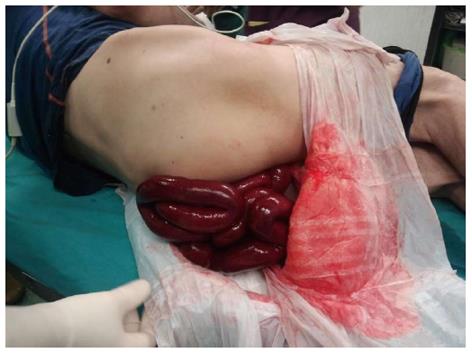Published online Feb 7, 2013. doi: 10.3748/wjg.v19.i5.776
Revised: November 12, 2012
Accepted: November 24, 2012
Published online: February 7, 2013
Processing time: 111 Days and 20.2 Hours
A postoperative complication after Altemeier operation, so far never reported, is described in a 42 years old mentally disabled patient with external full thickness rectal prolapse who usually had prolonged straining at defecation. After 6 d from perineal rectosigmoidectomy, the patient, was discharged free of complications. Four days later he was readmitted in emergency for strangulated perineal trans-anastomotic ileal hernia that occurred at home during efforts to defecate. The clinical feature required an emergency operation for repositioning the ileal loops into the abdomen, resection of the necrotic ileum, and end colostomy. The outcome of the second operation was free of complication and the patient was discharged on the 6th postoperative day. In conclusion, after Altemeier operation prolonged straining at defecation should be carefully avoided
- Citation: Di Lena M, Angarano E, Giannini I, Guglielmi A, Altomare DF. Strangulated ileal trans-coloanal-anastomotic hernia: A complication of Altemeier’s procedure previously never reported. World J Gastroenterol 2013; 19(5): 776-777
- URL: https://www.wjgnet.com/1007-9327/full/v19/i5/776.htm
- DOI: https://dx.doi.org/10.3748/wjg.v19.i5.776
Full thickness rectal prolapse is an uncommon but very disabling anorectal disease affecting any age and in particular mentally disabled patients. Several surgical approaches have been proposed to treat this disorder including abdominal rectopexy and perineal mucosal (Delorme) or full thickness rectal resection (Altemeier). The Altemeier’s procedure is usually preferred (1) in elderly, high-risk, frail patients unsuitable for abdominal operation; (2) for emergency incarcerated external prolapse[1] and for gangrenous rectal prolapse[2]; and (3) in mentally disabled patients because of its short, painless postoperative course and low complication rate.
A 42-year-old male patient affected by congenital hypothyroidism with a psychomotor retardation, anorexia and bulimia was admitted to our Colorectal Unit because of irreducible full thickness rectal prolapse. From several years the patient used to have prolonged and forced straining at defecation (about 30 min) with exteriorization of the prolapse at every defecation. However, in the last 2 mo the rectal prolapse became irreducible. A perineal rectosigmoidectomy with levatorplasty (Altemeier’s operation) was performed under general anesthesia with the patient in jack-knife position. Twelve cm of prolapsed rectum was resected and a hand-sewn interrupted coloanal anastomosis was performed. The patient was discharged on the 6th postoperative day free of complication and oral laxatives and antithrombotic prophylaxis were prescribed. Four days later the patient was re-admitted in emergency since a strangulated ileal trans-coloanal-anastomotic hernia occurred after a prolonged and strain defecation (Figure 1). Laparotomy was urgently performed and no signs of intrabdominal infection or ascites were found. However, the distal part of the ileum (about 2 m) was herniated outside the pelvis through a partial posterior dehiscence of the colo-anal anastomosis with torsion of intestinal loops around the vascular stalk. The large portion of small intestine herniated was reduced with difficulty into the abdomen with the help of a second operator from the perineal side. Once the ileum was replaced into the abdomen, the coloanal anastomosis was fully opened and the anus temporarily closed with continue resorbable suture. The vitality of the herniated ileum (up to 5 cm from the ileo-cecal valve) was poor after one hour and, therefore, it was resected. Then, a hand-sewn ileo-cecal anastomosis and a diverting sigmoid end colostomy were performed. The second postoperative course was uneventful and the patient was discharged on the 6th postoperative day. The patient was re-evaluated at follow-up for 4 mo and he is now waiting for a refashioning of the colo-anal anastomosis.
Altemeier’s procedure is usually recommended in mentally disabled patients with full thickness rectal prolapse because of its short and painless postoperative course. Postoperative complications are uncommon (less than 10%[3,4] of cases), nevertheless they usually occur in the early postoperative days. The complication we herein described, to our knowledge for the first time, was unexpected since it occurred several days after the patient was discharged in good clinical condition and with normal bowel movements.
We suggest that anamnestic data of the behavior of prolonged straining at defecation in mentally disabled patients should have been considered, and adequate advise given to the relatives to assist patients during defecation in order to prevent strain. Finally, the choice of creating a diverting sigmoidostomy instead of trying to repair the coloanal anastomosis seems more prudent, due to the presence of edema in traumatized anastomotic leakage.
P- Reviewer Kim NK S- Editor Gou SX L- Editor A E- Editor Zhang DN
| 1. | Zuo ZG, Song HY, Xu C, Li J, Ni SC, Zhou ZH, Chen SQ. [Application of Altemeier procedure in the emergent management of acute incarcerated rectal prolapse]. Zhonghua Wei Chang Wai Ke Zazhi. 2010;13:427-429. [PubMed] |
| 2. | Voulimeneas I, Antonopoulos C, Alifierakis E, Ioannides P. Perineal rectosigmoidectomy for gangrenous rectal prolapse. World J Gastroenterol. 2010;16:2689-2691. [RCA] [PubMed] [DOI] [Full Text] [Full Text (PDF)] [Cited by in CrossRef: 22] [Cited by in RCA: 23] [Article Influence: 1.5] [Reference Citation Analysis (1)] |
| 3. | Pescatori M, Zbar AP. Tailored surgery for internal and external rectal prolapse: functional results of 268 patients operated upon by a single surgeon over a 21-year period*. Colorectal Dis. 2009;11:410-419. [RCA] [PubMed] [DOI] [Full Text] [Cited by in Crossref: 31] [Cited by in RCA: 29] [Article Influence: 1.8] [Reference Citation Analysis (0)] |
| 4. | Altomare DF, Binda G, Ganio E, De Nardi P, Giamundo P, Pescatori M. Long-term outcome of Altemeier’s procedure for rectal prolapse. Dis Colon Rectum. 2009;52:698-703. [RCA] [PubMed] [DOI] [Full Text] [Cited by in Crossref: 86] [Cited by in RCA: 55] [Article Influence: 3.4] [Reference Citation Analysis (1)] |









